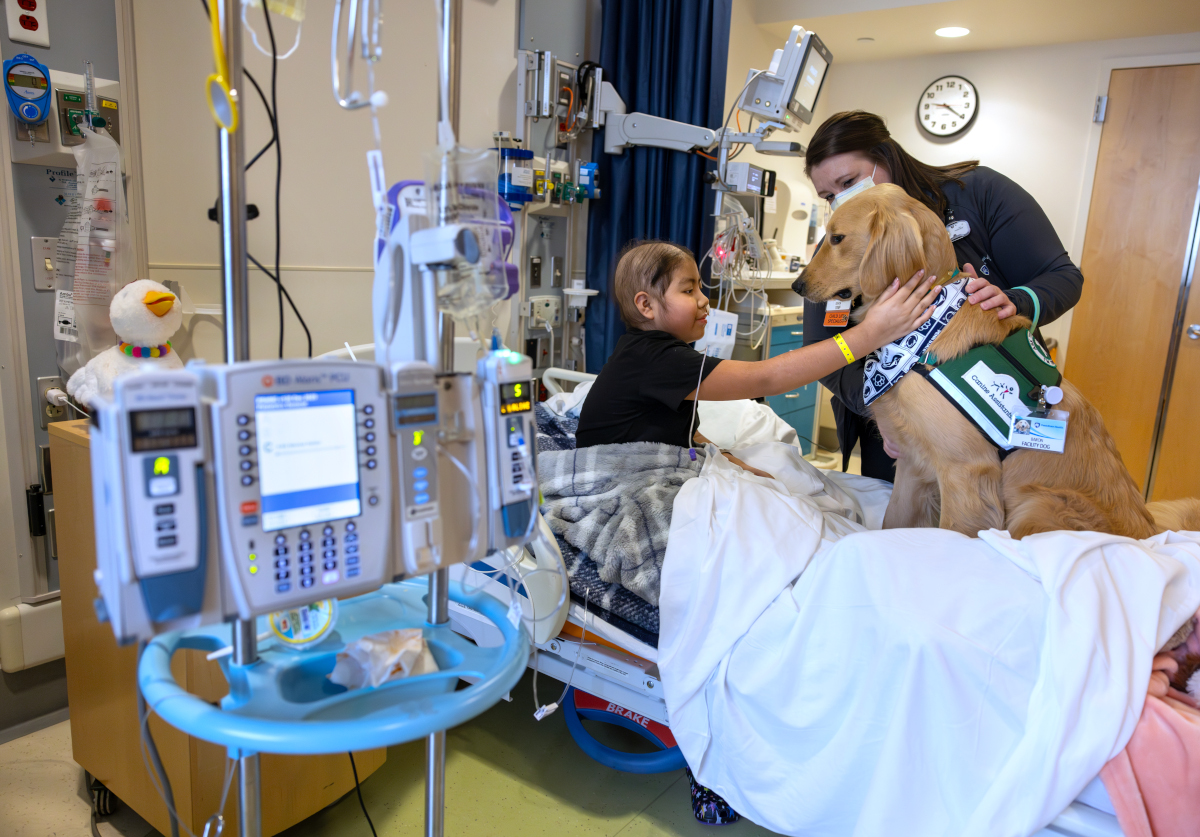Four-legged, furry royalty joins Milton S. Hershey Medical Center: Meet Baron

The facility dog program at Penn State Health Milton S. Hershey Medical Center is gaining some four-legged prestige with a new royalty-inspired pack member: Baron. Baron joined the unique team of full-time furry employees at Milton S. Hershey Medical Center on March 11.
Baron works with his primary handler, Devon Gulick, a certified child life specialist, and his secondary handler, Alexis Steefel, an art therapy supervisor and a registered and board-certified art therapist. Baron will work primarily with inpatients in the Pediatric Hematology/Oncology unit at Penn State Health Children’s Hospital. He will also join his colleague Pilot, a black golden retriever, to cover other inpatient units as necessary. Baron’s main duties will be to lower stress, provide diversion during procedures and tests and bring comfort to young patients staying at the Children’s Hospital.
“Every day, we see the positive, uplifting effect our facility dogs have on patients at the Children’s Hospital,” Gulick said. “We are so excited to work with Baron to bring even more of that joy to our patients.”
 Baron was raised by Canine Assistants in Georgia. In Georgia, Baron learned skills specific to working with young patients, such as how to work with IV poles and wheelchairs and how to rest gently near or with children. Gulick and Steefel traveled there to meet Baron and learn how to integrate him into their daily tasks while providing high-quality, safe patient care.
Baron was raised by Canine Assistants in Georgia. In Georgia, Baron learned skills specific to working with young patients, such as how to work with IV poles and wheelchairs and how to rest gently near or with children. Gulick and Steefel traveled there to meet Baron and learn how to integrate him into their daily tasks while providing high-quality, safe patient care.
Milton S. Hershey Medical Center became the first hospital in Pennsylvania to establish a facility dog program in 2016 when its first employee, a golden retriever named Kaia, started on the job. Since its inception, Pilot, litter mates and brothers Captain and Thor, and Skye have also joined the team. Each of these dogs are full-time employees of Milton S. Hershey Medical Center and Penn State Health Children’s Hospital and work in different specialized areas to enhance patient care. They spend 40 hours a week at work with their primary handlers, with time allowed for downtime, naps and walks. They have their own Instagram channel dedicated to educating the public on the purpose of the facility dog program and the work they do with the Child Life team at the Children’s Hospital.
The facility dog program is separate from the Pet Therapy Program, which continues to have an important presence in both the Children’s Hospital and adult hospital. The two programs have different kinds of training and help patients in different ways. Facility dogs undergo extensive training to work in a health care environment and provide emotional support, as well as learn specific tasks to help patients cope with major and minor hospital procedures. Pet therapy dogs offer companionship and a calming and therapeutic influence for patients.
The facility dog program is sustained by ongoing funding from many donors including the inaugural anonymous benefactor who helped purchase the first facility dog. The Kelso Facility Dog Endowment, in honor of their dog, provides support across the program, including the cost of caring for the dogs and their eventual retirement.
Gifts like these advance the University’s historic land-grant mission to serve and lead. Through philanthropy, alumni and friends are helping students to join the Penn State family and prepare for lifelong success; driving research, outreach and economic development that grow our shared strength and readiness for the future; and increasing the University’s impact for families, patients, and communities across the Commonwealth and around the world. Learn more by visiting raise.psu.edu.
If you're having trouble accessing this content, or would like it in another format, please email Penn State Health Marketing & Communications.
